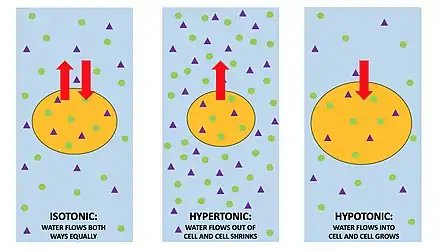Osmotic shock
Osmotic shock or osmotic stress is physiologic dysfunction caused by a sudden change in the solute concentration around a cell, which causes a rapid change in the movement of water across its cell membrane. Under hypertonic conditions - conditions of high concentrations of either salts, substrates or any solute in the supernatant - water is drawn out of the cells through osmosis. This also inhibits the transport of substrates and cofactors into the cell thus “shocking” the cell. Alternatively, under hypotonic conditions - when concentrations of solutes are low - water enters the cell in large amounts, causing it to swell and either burst or undergo apoptosis.[1]

All organisms have mechanisms to respond to osmotic shock, with sensors and signal transduction networks providing information to the cell about the osmolarity of its surroundings;[2] these signals activate responses to deal with extreme conditions.[3] Cells that have a cell wall tend to be more resistant to osmotic shock because their cell wall enables them to maintain their shape.[4] Although single-celled organisms are more vulnerable to osmotic shock, since they are directly exposed to their environment, cells in large animals such as mammals still suffer these stresses under some conditions.[5] Current research also suggests that osmotic stress in cells and tissues may significantly contribute to many human diseases.[6]
In eukaryotes, calcium acts as one of the primary regulators of osmotic stress. Intracellular calcium levels rise during hypo-osmotic and hyper-osmotic stresses.
Recovery and tolerance mechanisms
For hyper-osmotic stress
Calcium plays a large role in the recovery and tolerance for both hyper and hypo-osmotic stress situations. Under hyper-osmotic stress conditions, increased levels of intracellular calcium are exhibited. This may play a crucial role in the activation of second messenger pathways.[7]
One example of a calcium activated second messenger molecule is MAP Kinase Hog-1. It is activated under hyper-osmotic stress conditions[8] and is responsible for an increase in the production of glycerol within the cell succeeding osmotic stress. More specifically, it works by sending signals to the nucleus that activate genes responsible for glycerol production and uptake.[8]
For hypo-osmotic stress
Hypo-osmotic stress recovery is largely mediated by the influx and efflux of several ions and molecules. Cell recovery after hypo-osmotic stress has shown to be consistent with an influx of extracellular Calcium.[9] This influx of calcium may alter the cell's permeability.[9]
Additionally, some organisms have been shown to use phenothiazines to regulate and prevent the efflux of amino acids. Changes in the cell's permeability allows the efflux of amino acids during recovery.[9]
Hypo-osmotic stress is correlated with extracellular ATP release. ATP is used to activate purinergic receptors.[10] These receptors regulate sodium and potassium levels on either side of the cell membrane.
Osmotic damage in humans
See also
- Osmolyte
- Myo-Inositol
- Taurine and Taurine-transporting ATPase
- Creatine
- Betaines
- Trimethylglycine – A Betaine and metabolite of Choline
- Sorbitol
- Glycerophosphocholine
References
- Lang KS, Lang PA, Bauer C, Duranton C, Wieder T, Huber SM, Lang F (2005). "Mechanisms of suicidal erythrocyte death". Cellular Physiology and Biochemistry. 15 (5): 195–202. doi:10.1159/000086406. PMID 15956782.
- Kültz D, Burg M (November 1998). "Evolution of osmotic stress signaling via MAP kinase cascades". The Journal of Experimental Biology. 201 (Pt 22): 3015–21. doi:10.1242/jeb.201.22.3015. PMID 9787121.
- Kültz D (November 2007). "Osmotic stress sensing and signaling in animals". The FEBS Journal. 274 (22): 5781. doi:10.1111/j.1742-4658.2007.06097.x. PMID 17944944.
- "Unique Characteristics of Prokaryotic Cells".
{{cite web}}: CS1 maint: url-status (link) - Ho SN (January 2006). "Intracellular water homeostasis and the mammalian cellular osmotic stress response". Journal of Cellular Physiology. 206 (1): 9–15. doi:10.1002/jcp.20445. PMID 15965902. S2CID 21178769.
- Brocker C, Thompson DC, Vasiliou V (August 2012). "The role of hyperosmotic stress in inflammation and disease". Biomolecular Concepts. 3 (4): 345–364. doi:10.1515/bmc-2012-0001. PMC 3438915. PMID 22977648.
- Erickson, Geoffrey R.; Alexopoulos, Leonidas G.; Guilak, Farshid (2001). "Hyper-osmotic stress induces volume change and calcium transients in chondrocytes by transmembrane, phospholipid, and G-protein pathways". Journal of Biomechanics. 34 (12): 1527–1535. doi:10.1016/S0021-9290(01)00156-7. PMID 11716854.
{{cite journal}}: CS1 maint: url-status (link) - Kim, Jiyoung; Oh, Junsang; Sung, Gi-Ho (2016). "MAP Kinase Hog1 Regulates Metabolic Changes Induced by Hyperosmotic Stress". Frontiers in Microbiology. 7: 732. doi:10.3389/fmicb.2016.00732. PMC 4870262. PMID 27242748.
- Pierce, Sidney K.; Politis, Alexander D.; Smith, Laurens H.; Rowland, Laura M. (1988). "A ca2+ Influx in Response to Hypo-Osmotic Stress May Alter Osmolyte Permeability by a Phenothiazine-Sensitive Mechanism". Cell Calcium. 9 (3): 129–140. doi:10.1016/0143-4160(88)90016-4. PMID 3138029.
{{cite journal}}: CS1 maint: url-status (link) - Shahidullah, M.; Mandal, A.; Beimgraben, C.; Delamere, N.A. (2012). "Hyposmotic Stress Causes ATP Release and Stimulates Na,K‐ATPase Activity in Porcine Lens". Journal of Cellular Physiology. 227 (4): 1428–1437. doi:10.1002/jcp.22858. PMID 21618533. S2CID 22378117.
{{cite journal}}: CS1 maint: url-status (link)